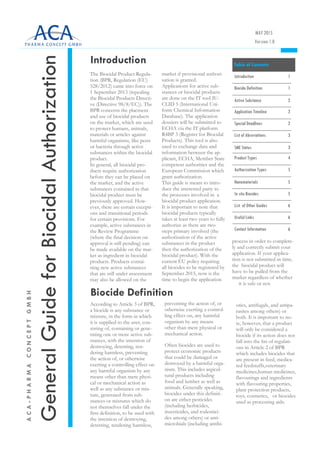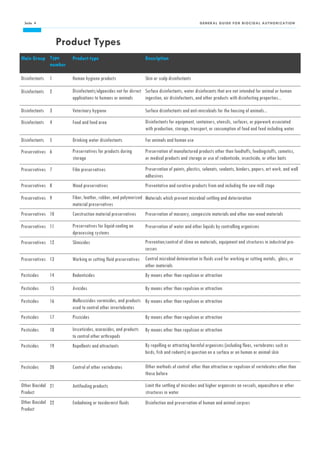The document discusses regulations around biocidal products in the European Union. It provides definitions and explains that under the Biocidal Product Regulation, all biocidal products must be authorized before being placed on the market. Applications require approval of both the active substances within biocidal products and of the products themselves, a process that typically takes at least two years. The deadline for existing biocidal products to complete authorization is September 2015.

![by ECHA before entering the market.
In situ biocides must submit their dossiers
which include the suppliers of the precur-
sors as well as information on the biocide
produced to ECHA for evaluation by the
1st of September 2015.
Articles treated with biocides must have
submitted their applications by the 1st of
September 2016 unless it contains ative
substances that have not been yet recogn-
zed by ECHA in which case it has until
March 1st 2017.
Biocidal products with SVHCs/candidates
for substitution as active substances or
non-active components must be regis-
tered by September 1st 2015 and since
ECHA is attempting to replace SVHCs,
these products cannot be authorized for
more than five years.
Seite 2 GENERAL GUIDE FOR BIOCIDAL AUTHORIZATION
Application Timeline
Submission
of Application
Validation
For substances currently
on the market, submissi-
on must occur by the:
1st of September 2015
Fee
payment
Requested
information
BPC
decision
30 30 90 365 270 days
Comments
on draft
30Dossier
evaluation
Committee
decision for
authorization
The time for authorization of a biocidal product is approximately two years. The time required for
a dossier evaluation and BPC decision are approximate. The time required for the final committee
decision on authorization is highly variable. Also, should additional information be requested
during the dossier evaluation, an additional 180 days may be given to provide the necessary data.
Biocidal authorization can be granted
for up to 10 years. If the biocidal pro-
duct contains a substance that is up for
substitution, the biocidal product can-
not get granted authorization for more
than 5 years.
If the substance in question is already
under the jurisdiction of a previous
biocidal regulation, it does not have to
follow current ECHA biocidal regulati-
ons. Materials which wish to enter the
European market must be approved
Special Deadlines
Additional
information
180
EU
authorization
Before any biocidal product is approved by ECHA, the active substances that are part of a biocidal function must be ap-
proved and authorized for use in the EU through ECHA.
The first step to do this is to submit a IUCLID active substance portfolio to a member state‘s competenet authority via
R4BP3. After the member state has evaluated the substance, ECHA‘s biocidal comittee will also decide on the status of
the active substance in question within 270 days. [For further information on how to use and submit the required informa-
tion to ECHA for approval, please see ACA-Pharma Concept‘s IUCLID guide to Biocides]
These opinions serve as the basis for the decision on approval which is then adopted by the European Commission. Gai-
ning approval for the active substance can take well over a year, so it is important to start the approval process as soon as
possible. Once approval has been granted, an active substance‘s approval can be granted for up to 10 years and is rewable.
In principle, active substances meeting the exclusion criteria defined in the BPR will not be approved. However, sub-
stances of very high concern, such as those that are carcinogenic, mutagenic and reprotoxic substances in categories 1A
or 1B in CLP Regulation, endocrine disruptors, and substances which are persistent bioaccumulative and toxic (PBT) or
are very persistent and very bioacumulative (vPvB) will not be approved unless there are no alternatives available. If the
substance of high concern is indeed the only option, it can only be approved for up to five years and is subject to evaulati-
on in the case of a better, safer substitute.
Biocidal Products Committee opinions on active substance approval can be viewed on ECHA Homepage. European
Commission includes approved active substances in the Union list of approved active substances (formerly Annex I of
Directive 98/8/EC). Companies wishing to get an authorisation for a biocidal product can consult this list to identify ac-
tive substances for use in biocidal products and treated articles.
A consolidated list of existing active substances for which a decision of non-inclusion into Annex I or IA of Directive
98/8/EC has been adopted is also available. Biocidal products containing active substances for which a non-inclusion
decision was taken shall be removed from the market within 12 months of the entering into force of such decision; unless
otherwise stipulated in that non-inclusion decision.
Active Substance Authorization](https://image.slidesharecdn.com/e4ec2c56-945f-43de-8a8e-2e13acf49068-151011164852-lva1-app6892/85/General-Biocides-Booklet-2-320.jpg)



![ IUCLID Manual for
Biocides
CLP Manual for
Biocides
Other Guides
BioCity Leipzig
Deutscher Platz 5
D-04103 Leipzig
ACA-Pharma Concept GmbH
Telefon: +49 341 33 73 33 60
Fax: +49 341 33 73 33 69
E-Mail: aca24@aca-pharma.de
Useful Links
ACA-Pharma Concept GmbH/Biocides
[http://aca-pharma.de/chemicals-biocides/]
ECHA/Biocidal Products Regulation
[http://eur-lex.europa.eu/legal-content/EN/TXT/PDF/?uri=CELEX:02012R0528-
20140425&from=EN]
ECHA/Application of CLP regulation
[http://echa.europa.eu/documents/10162/13562/clp_en.pdf]
ECHA/Data sharing
[http://echa.europa.eu/documents/10162/13631/guidance_on_data_sharing_en.pdf]](https://image.slidesharecdn.com/e4ec2c56-945f-43de-8a8e-2e13acf49068-151011164852-lva1-app6892/85/General-Biocides-Booklet-6-320.jpg)